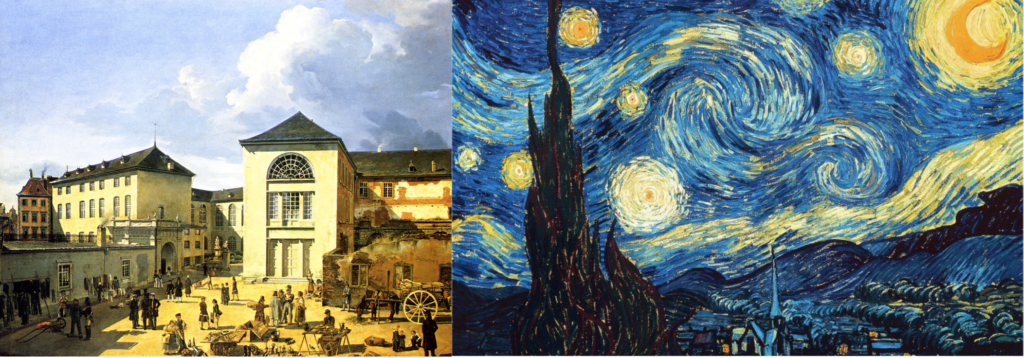Visual and Plastic Arts Education English 1º, 2º and 4º E. Primaria
Lengua Castellana 5º E. P.
The artist as an inventor

The evolution of the arts
The evolution of the architectural, sculptural, pictorial (painting) and cinematic arts from their origins to the present day represents a vast and complex history, marked by innovations, cultural exchanges, and technological advancements. Here’s a brief overview:
a) Architectural Arts: The evolution of architecture traces back to the construction of simple shelters and monumental structures of ancient civilizations, like the pyramids of Egypt and the ziggurats of Mesopotamia. Classical architecture introduced the use of columns and post-and-lintel construction, evident in Greek and Roman structures. The Middle Ages saw the rise of Gothic architecture, characterized by pointed arches and elaborate stone carvings. The Renaissance period revived classical principles, emphasizing symmetry and proportion. The Industrial Revolution brought new materials like steel and concrete, leading to modern skyscrapers and the International style. Contemporary architecture often focuses on sustainability, technological innovation, and blending with the natural environment.
b) Sculptural Arts: Sculpture has evolved from the totemic figures of prehistoric times to the highly stylized statues of ancient Egypt and the idealized forms of classical Greece and Rome. Medieval sculpture was closely tied to religion, while the Renaissance revived classical themes and techniques, emphasizing humanism and naturalism. The Baroque period introduced dynamic, emotional expressions and dramatic effects. Modern sculpture broke away from traditional methods, exploring abstract forms and a wide range of materials. Contemporary sculpture often incorporates multimedia and interactive elements, challenging the traditional boundaries of the art form.
c) Pictorial Arts (Painting): Painting has its origins in cave paintings of prehistoric times. Ancient civilizations like the Egyptians used painting for decorative and ceremonial purposes. The Middle Ages saw the dominance of religious themes in painting, with the use of frescoes and illuminated manuscripts. The Renaissance marked a return to realism, perspective, and human-centered themes. The Baroque and Rococo periods introduced dramatic uses of light and color. The 19th century saw the rise of movements like Impressionism, which focused on light and movement. The 20th century brought about a plethora of movements, including Cubism, Surrealism, and Abstract Expressionism, radically changing the concept of painting. Contemporary painting continues to explore diverse themes and techniques, reflecting a wide range of cultural and personal expressions.
d) Theater: During the Middle Ages, theater in Europe took a religious turn with the performance of liturgical dramas in Latin within the church’s confines. However, by the late Middle Ages, theater began to secularize, moving outside the church with the development of mystery, morality, and miracle plays that were performed in the vernacular, making them more accessible to the general public.
The Renaissance brought a revival of interest in classical literature and art, leading to the flourishing of theater in Italy with Commedia dell’arte, a form of improvisational theater that heavily influenced European drama. This period also saw the rise of the Elizabethan era in England, with William Shakespeare and his contemporaries transforming English drama through their masterful plays that explored human nature and society.
The 17th and 18th centuries saw the establishment of neoclassical ideals in theater, emphasizing harmony, decorum, and the unities of time, place, and action. This period also witnessed the rise of opera and ballet, integrating music, dance, and spectacle into theatrical performances.
The 19th century introduced Romanticism, which celebrated the individual and emotions, leading to more elaborate productions and the advent of melodrama. This era also saw the beginning of realism and naturalism, with playwrights like Henrik Ibsen and Anton Chekhov focusing on everyday life and social issues, challenging traditional theatrical conventions.
The 20th century brought further innovation with the emergence of modernism, exploring new forms and themes, including the absurdism of Samuel Beckett and the epic theater of Bertolt Brecht, which sought to provoke thought and action among audiences. The latter half of the century and the early 21st century have seen the continuation of diverse theatrical movements, including postmodernism, which challenges narratives and structures, and the digital revolution, which has introduced new technologies and platforms for performance, expanding the boundaries of what theater can be.
Today, theater continues to evolve, reflecting and shaping the complexities of modern society. It embraces a wide range of genres, styles, and formats, from traditional stage performances to immersive and interactive experiences, showing the enduring power of live performance to connect, challenge, and entertain audiences around the world.
e) Cinematic Arts: Cinema, a relatively modern art form, began in the late 19th century with the invention of the motion picture camera. Early films were short and silent, evolving into longer narratives and the introduction of sound in the 1920s. The Golden Age of Hollywood in the 1930s and 1940s established the studio system and star system. Post-World War II, cinema saw the rise of neorealism, the French New Wave, and other international movements that emphasized realism, authorial vision, and innovative storytelling techniques. The late 20th and early 21st centuries have been marked by the advent of digital filmmaking, the rise of independent cinema, and global cinema, highlighting diverse voices and stories. Today, cinema continues to evolve with advances in technology and shifts in audience consumption, including streaming platforms.
This overview only scratches the surface of the rich and diverse evolution of these art forms, each of which reflects the complex interplay of cultural, technological, and artistic innovations over time.





Artists’ opinions on art
- Beauty perishes in life, but it is inmortal in art (Leonardo da Vinci)
- Painting is silent poetry, poetry is blind paintig (Plutarco)
- Every artist dips his brush in his own soul, and paints his own nature into his pictures (Henry Ward Beecher)
- A picture is a poem without words (Horacio)
- The esence of all art is to have pleasure in giving pleasure (Dale Carnegie)
- Art is a harmony parallet with nature (Paul Cézane)
